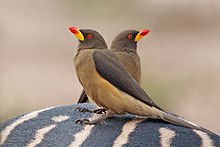| Oxpeckers | |
|---|---|

| |
| Yellow-billed oxpeckers Buphagus africanus africanus on a zebra in Senegal | |
| Scientific classification | |
| Domain: | Eukaryota |
| Kingdom: | Animalia |
| Phylum: | Chordata |
| Class: | Aves |
| Order: | Passeriformes |
| Superfamily: | Muscicapoidea |
| Family: | Buphagidae Lesson, 1828 |
| Genus: | Buphagus Brisson, 1760 |
| Type species | |
| Buphaga africana[1] Linnaeus, 1766
| |
| Species | |

The oxpeckers are two species of bird which make up the genus Buphagus, and family Buphagidae. The oxpeckers were formerly usually treated as a subfamily, Buphaginae, within the starling family, Sturnidae, but molecular phylogenetic studies have consistently shown that they form a separate lineage that is basal to the sister clades containing the Sturnidae and the Mimidae (mockingbirds, thrashers, and allies). Oxpeckers are endemic to the savanna of Sub-Saharan Africa.
Both the English and scientific names arise from their habit of perching on large mammals (both wild and domesticated) such as cattle, zebras, impalas, hippopotamuses, rhinoceroses, and giraffes, eating ticks, small insects, botfly larvae, and other parasites, as well as the animals' blood. The behaviour of oxpeckers towards large mammals was thought to be exclusively mutual, though recent research suggests the relationship can be parasitic in nature as well.[2]
The Swahili name for the red-billed oxpecker is Askari wa kifaru (the rhino's guard).[3]
- ^ "Buphagidae". aviansystematics.org. The Trust for Avian Systematics. Retrieved 2023-07-15.
- ^ Eschner, Kat (22 September 2017). "Those Little Birds On The Backs Of Rhinos Actually Drink Blood". Smithsonian. Retrieved 9 March 2019.
- ^ Shoot, Britta (10 June 2020). "These Birds Protect Black Rhinos From Poachers (but Also Drink Their Blood)". Audubon.